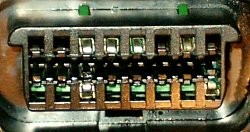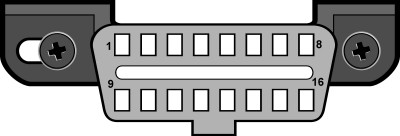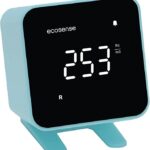Understanding whether your car is OBD2 compliant is crucial for modern vehicle diagnostics and maintenance. OBD2 (On-Board Diagnostics II) is a standardized system that allows you to access your car’s health information using a scan tool. But how do you determine if your vehicle adheres to this standard? This guide will walk you through the steps to check your car’s OBD2 compliance, ensuring you can effectively monitor its performance and address any issues.
Understanding OBD-II Compliance: It’s About Where You Bought It, Not Where It Was Made
It’s a common misconception that OBD2 compliance is determined by where your car was manufactured. In reality, OBD2 compliance is based on the country where the vehicle was originally sold as new and the model year. This distinction is important because emissions regulations and vehicle standards vary across different regions.
For instance, in the United States, legislation mandated that all cars and light trucks model year 1996 and newer must be OBD2 compliant. This was a significant step towards standardized vehicle diagnostics. You can find more detailed information on the EPA’s website.
Similarly, the European Union introduced OBD compliance in phases. For petrol (gasoline) vehicles, full OBD-II compliance was mandatory for models sold from 2002 onwards, with limited compliance starting from 2001. Diesel vehicles in the EU achieved full OBD-II compliance from 2007 onwards, with limited compliance from 2004-2006. These regulations were part of directives like Commission Directive 70/220/EEC, aimed at controlling vehicle emissions.
For vehicles sold in other countries, the implementation timelines for OBD-II compliance vary. A helpful overview is provided in the table below, detailing OBD-II compliance by country of sale and model year. Remember to always refer to the country where your vehicle was initially sold to determine applicability.
| Country of Sale | Model Years | Notes |
|---|---|---|
| United States | 1996 | |
| European Union (Diesel) | Full OBD-II Compliance for 2007 and onward | Limited Compliance from 2004-06 |
| European Union(Petrol) | Full OBD-II Compliance for 2002 and onward | Limited Compliance from 2001 |
| Canada | 1998 | |
| Algeria | 2014 | |
| Argentina (Domestic) | 2008 | |
| Argentina (Imports) | 2009 | |
| Australia (Diesel) | 2007 | |
| Australia (Petrol) | 2006 | |
| Bahrain | Full OBD-II Compliance for 2018 and onward | Limited Compliance from 2017-18 |
| Brazil (Petrol) | Full OBD-II Compliance for 2007 and onward | Limited Compliance from 2005-06 |
| Brazil (Diesel) | Full OBD-II Compliance for 2015 and onward | Limited Compliance from 2013-14 |
| Chile (Diesel) | 2013 | |
| Chile (Petrol) | 2014 | |
| China (Beijing – Petrol) | 2008 | |
| China (Country – Diesel) | 2011 | |
| China (Country – Petrol) | 2010 | |
| Costa Rica | Limited Compliance from 2017 onward | |
| Hong Kong | 2006 | |
| India | Full OBD-II Compliance for 2017 and onward | Limited Compliance from 2013-16 |
| Iran | 2012 | |
| Israel | 2003 | |
| Japan | Full OBD-II Compliance for 2008 and onward | Limited Compliance from 2003-07 |
| Kuwait | Full OBD-II Compliance for 2018 and onward | Limited Compliance from 2017-18 |
| Mexico | 2007 | |
| Morocco | 2010 | |
| New Zealand (Diesel) | 2007 | |
| New Zealand (Petrol) | 2006 | |
| Nigeria | 2015 | |
| Oman | Full OBD-II compliance for 2018 and onward | Limited Compliance from 2017-18 |
| Peru | 2003 | |
| Peru | 2017 | |
| Philippines | 2016 | |
| Qatar | Full OBD-II Compliance for 2018 and onward | Limited Compliance from 2017-18 |
| Russia | Full OBD-II Compliance for 2012 and onward | Limited Compliance from 2010-11 |
| Saudi Arabia | Full OBD-II Compliance for 2018 and onward | Limited Compliance from 2017-18 |
| Singapore | 2014 | |
| South Korea | Full OBD-II Compliance for 2010 and onward | Limited Compliance from 2005-09 |
| Taiwan | 2008 | |
| Thailand | 2013 | |
| Turkey | 2013 | |
| United Arab Emirates | Full OBD-II Compliance for 2018 and onward | Limited Compliance from 2017-18 |
| Vietnam | 2017 | |
| Yemen | Full OBD-II Compliance for 2018 and onward | Limited Compliance from 2017-18 |


Note: Hybrid and Electric vehicles, being low or zero emission vehicles, may have limited or no OBD-II compatibility with standard scan tools. Always consult your vehicle manual or dealership for specifics regarding these vehicle types.
Quick Ways to Check for OBD-II Compliance
Beyond the model year and country of sale, there are visual and documentary checks you can perform:
1. Check the Vehicle Emission Control Information Label
A straightforward method is to locate the Vehicle Emission Control Information (VECI) label, typically found under the hood. This label often explicitly states OBD-II compliance.
Look for phrases like “OBD II compliant,” “OBD II certified,” “EOBD” (European On-Board Diagnostics), or “JOBD” (Japanese On-Board Diagnostics). These terms are generally used interchangeably with OBD-II in different regions and indicate compliance with similar standards.
2. Consult Your Vehicle Owner’s Manual
Your vehicle’s owner’s manual can also provide information about OBD-II compliance. Look for a section discussing emissions or diagnostics, which may mention OBD-II or related terms.
3. Check with Your Dealer (With a Caveat)
You can contact your local car dealership for confirmation. However, be aware that some dealers might not fully understand the nuances between OBD and OBD-II. It’s best to be specific and ask directly about OBD-II compliance for your vehicle’s model year and country of sale.
The 16-Pin Connector: Not a Guaranteed Sign of OBD-II
Many people assume that if their car has a 16-pin Diagnostic Link Connector (DLC), it is automatically OBD-II compliant. While OBD-II compliant vehicles do use a standardized 16-pin connector, the presence of this connector alone does not guarantee OBD-II compliance.
Especially in the years leading up to mandatory OBD-II implementation, many European and Asian manufacturers equipped their vehicles with 16-pin connectors that were not fully OBD-II compliant. These pre-OBD-II connectors might look similar but lack the complete functionality and standardized communication protocols of OBD-II.
A subtle visual cue can sometimes indicate a non-EOBD compliant connector. As seen in the example of an older Ford Focus, some non-compliant connectors have distinctive “ears” or flanges that deviate from the standardized SAE J1979 connector shape used for OBD-II.
Therefore, while checking for a 16-pin connector is a good starting point, it should not be the sole basis for determining OBD-II compliance. Always combine this check with other methods like the VECI label and the compatibility chart for a definitive answer.
Using the OBD-II Compatibility Chart
The provided compatibility chart is a valuable tool. To use it effectively:
- Identify the country where your vehicle was originally sold new. This is crucial, not the country of manufacture.
- Determine your vehicle’s model year. This information is usually found in your vehicle documents.
- Locate the country and model year range in the chart.
The chart will indicate whether your vehicle is fully OBD-II compliant, has limited compliance, or is not compliant based on these factors.
Conclusion: Ensuring OBD-II Compatibility for Effective Diagnostics
Knowing if your car is OBD2 compliant is the first step towards utilizing OBD-II scan tools for vehicle diagnostics and maintenance. By checking the VECI label, consulting the compatibility chart based on your car’s country of sale and model year, and being aware of the 16-pin connector caveat, you can confidently determine your vehicle’s OBD-II status. This knowledge empowers you to use the right tools for monitoring your car’s health and keeping it running smoothly.
